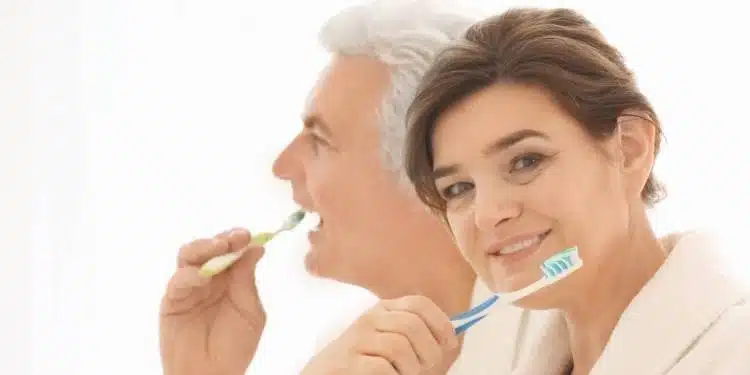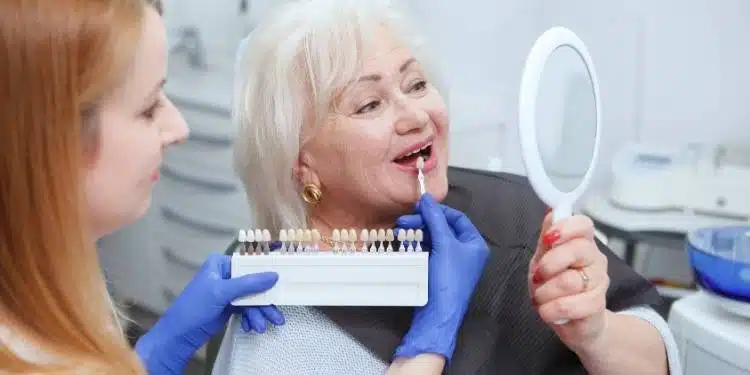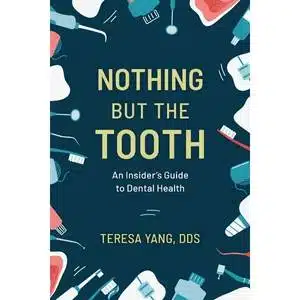by Teresa Yang, D.D.S., author of Nothing but the Tooth: An Insider’s Guide to Dental Health
Hair turns gray or disappears altogether, waistlines expand, and wrinkles form. Just as our bodies change as we age, our mouths are no different. Have you noticed changes in your mouth related to your teeth and aging?
Food Stuck in Teeth
Food seems to get stuck in my teeth after every meal these days. When I was younger, occasionally a piece of lettuce would call attention to itself in a conspicuous spot in my mouth. If my dining companion made eye contact and discreetly pointed to her mouth, I considered her a good friend. But now? After each meal, my tongue darts into crevices I didn’t use to search for stubborn food particles. I try to dislodge them, but still, I sometimes need to excuse myself to floss. Yes, I’ve actually taken to carrying dental floss around with me.
Why does this happen? Teeth are wider than their roots, so while the teeth touch each other, the roots do not. Bone, covered by a curtain of gum, encases the roots. In a 21-year-old mouth, there are no gaps or spaces that allow for food to get stuck. As we age, the bone around the roots may shrink. Since our gum tissue follows the contour of the bone much like a glove adapts to the shape of a hand, our gum may also recede, leaving gaps where none existed before.
I once received an emergency call on a Sunday from someone claiming to have a “weird growth in their gum.” In my mind, I envisioned referring this patient for a biopsy. But when I saw the 50-plus-year-old woman on Monday, the growth turned out to be food that was stuck for days in her teeth. Unaccustomed to this occurrence, she and I had a good laugh.
I wish I could provide an easy solution, but there isn’t one. Rather than saying, “Be grateful you have teeth,” maybe you also should consider carrying dental floss.
Why Are My Teeth Moving?
Great question. Teeth are not solidly fused to bone. A myriad of small fibers, referred to as the periodontal ligament (PDL), connect root surfaces to their surrounding bone and act as a shock absorber. Orthodontia and tooth movement happens because of the PDL.
Teeth move constantly over time without your knowing. In a process called mesial migration, teeth tend to move toward the center of the mouth. That’s why your lower front teeth may get more crowded as you age. In a 21-year-old, the upper front teeth are generally more visible. But as we age, skin loses elasticity and plumpness, and facial muscles sag. making the lower front teeth even more conspicuous.
You may also have gum disease. Seventy percent of people over the age of 65 show signs of gum or periodontal disease. Your teeth may lose some of their supporting bone, causing them to become loose, flare, or move.
Or perhaps you grind or clench your teeth. Putting undue pressure on certain teeth can also result in tooth movement.
Several times a day I hear from older patients, “My teeth used to be straight and now they’re crooked. Should I get braces?” Before I can address this question, I need to determine the cause of the tooth movement. If it turns out that orthodontia is the solution, the first step is to discuss the pros, cons, and alternatives of treatment so the patient can make an informed decision.

Why Do Teeth Yellow with Age?
Why do teeth seem to yellow with age? Patients tell me it seems to happen overnight.
Even though teeth are the hardest substance in our bodies, enamel is porous and absorbs everything you eat or drink. The usual culprits that cause discoloration include smoking, red wine, coffee, and any colored food such as blueberries, beets, or similar. After a lifetime of ingesting such items, it’s no wonder that teeth change color.
You can remove plaque and yellowish, hardened tartar with a dental cleaning. To the disappointment of many patients, many dentists stopped the routine polishing of teeth during the COVID-19 pandemic. Not only did the polishing remove surface stains, but it also provided patients with that “just cleaned” feeling.
Does bleaching help with discoloration?
Deeper, intrinsic stains may show improvement with bleaching. This process usually lightens teeth several shades and must usually be repeated over time to maintain the color. There are several ways to bleach your teeth.
A one or two-appointment procedure at your dentist’s office: This is the quickest approach, perfect for that last-minute reunion or wedding. But it’s once-and-done.
At-home bleaching with trays fabricated by your dentist: This method gives you the flexibility to touch up in the future. You simply need to replenish the bleaching gel. Sometimes patients combine the in-office bleaching for the initial color boost with the trays for periodic maintenance.
At-home bleaching with over-the-counter products: There are whole aisles of available products, consisting of strips, paint-on liquids, gels, mouthwashes, and toothpaste. Of these, Whitestrips showed superior efficacy compared to all other over-the-counter products.
Keep in mind that root surfaces and artificial materials, such as porcelain, will not bleach.

“My Smile Used to Be My Best Feature”
Some of the seniors visiting my office tell me how proud they once were of their straight, white teeth in their younger years. They say their smile was their best feature. Now, they find their teeth chipping, cracking, breaking, and in general, wearing down. Unfortunately, some of these issues are inevitable, the result of decades of use.
Here are some tips to minimize these problems:
- Avoid very hard foods such as bones.
- Don’t chew ice.
- Avoid acidic foods and beverages like lemons or certain sodas.
- Don’t chew on pencils, paper clips, fingernails, and the like.
- Have your dentist evaluate you for grinding or clenching and, if indicated, seek treatment.
- Also evaluate for acid reflux and, if necessary, seek treatment.
What if a tooth breaks?
If a tooth breaks or a filling or crown falls out, it’s important to address the problem. A small chip may not require treatment other than maybe some smoothing, so the tooth doesn’t cut your tongue. Conversely, a tooth that’s broken off at the gumline may need to be extracted. Several treatment options exist to replace the missing tooth. Discuss the pros and cons of the specific situation with your dentist.
Leave the space or fill it?
Perhaps you’re considering leaving the space? You may not be concerned with the appearance. However, depending on the location of the gap, a missing tooth can result in the shifting of the neighboring teeth. Multiple missing teeth, with their corresponding empty spaces, can lead to a collapse of your bite. Have you ever noticed an individual with few teeth whose lips are pressed and scrunched together? A stable set of back teeth gives structure and support to the overlying facial muscles and lips.
What Causes Dry Mouth?
Does your mouth feel dry all the time?
Prescription medication usage increases dramatically as we age. Some classes of medication, such as drugs to treat high blood pressure, cause reduced saliva flow and dry mouth. Peri-and post-menopausal women also commonly experience a significant reduction in saliva flow.
Saliva is critical in aiding digestion, preventing cavities, and combating disease. The lack of saliva can also contribute to a painful mouth or burning mouth syndrome. Plus, in combination with a dry mouth, factor in any gum recession that leaves root surfaces exposed. Roots are not covered and protected by enamel and are therefore more susceptible to decay. Moreover, filling root cavities presents a challenge for any dentist.
Mrs. M. used to come in every two or three months with her entourage – her beloved standard poodle, the dog walker, and her chauffeur/caregiver. She would snarl and wink at me simultaneously, saying, “I hate being here.” Little did she know that I also dreaded her visits because new root cavities appeared like unwanted mosquito bites each time.
Should dry mouth become a challenge, discuss the problem with your physician. It’s possible you can switch to an equally effective medication without this side effect. Or hormone replacement therapy may be considered. Alternatively, there are over-the-counter rinses that help with dry mouth. As always, drink plenty of water.

Should I Worry about Oral Cancer?
Although cancer can occur at any age, cancer from the human papillomavirus (HPV) deserves spotlighting. These cancers are not caused by smoking; rather, they’re related to sexual activity. Oropharyngeal HPV cancers typically occur at the back of the tongue or the throat and, due to their location, are challenging to see. The number of cases is increasing each year, with oropharyngeal cancer being the most common HPV-related cancer in the U.S. The median age at diagnosis for these cancers is 63 for women and 61 for men. If you have a persistent sore throat, chronic cough, hoarseness, or swallowing difficulty, I recommend you see your dentist or physician.
Michael Douglas, the actor and producer, was diagnosed with oropharyngeal HPV-related cancer at the age of 65. To help others, he is now a spokesperson for the importance of oral cancer screening.
What Does Snoring Have to Do with Dental Health?
Does your spouse complain about your snoring? Do they say it’s louder than ever these days?
It might surprise you to learn that your dentist is the ideal healthcare provider to screen for sleep apnea. Many people see their dentist more frequently than their primary care physician. And your dentist is already looking in your mouth, including the tongue and the tonsillar area.
Our skin is not the only thing that sags. The soft tissue at the back of the mouth and throat may loosen and relax, taking up more airway space. Or perhaps you’re 30 pounds heavier than you were at age 21, with a larger neck that also compromises airway space.
Snoring by itself may just be a nuisance. However, it may be an indication of sleep apnea, a more serious condition that can lead to adverse health consequences such as stroke, obesity, or impaired judgment. A sleep study may be warranted, and your dentist can refer you to the appropriate healthcare provider. Should you be diagnosed with sleep apnea, one of the potential treatments is an oral appliance which will be made by a dentist.

Understanding and Managing Age-Related Dental Changes
Rather than feeling depressed about issues related to your teeth and aging, try to adjust in a healthy manner. If teeth whitening or avoiding foods that cause acid reflux can improve a condition that distresses you, consider treatment. Know that conditions such as periodontal disease and sleep apnea are serious and require follow-up. Look into cosmetic dentistry if that will improve your overall outlook and self-esteem.
Actionable Steps for Healthy Dental Health
A positive attitude is one of the most important factors in how we age and approach life. Embrace and celebrate the natural aspects of aging! There are plenty of things you can do to promote dental health. Below are some easy-to-follow tips.
Practice good oral hygiene.
Brush your teeth at least twice a day for two minutes each time. Brushing before bed is critical. Consider investing in an electric toothbrush if your manual dexterity or eyesight are not what they used to be. If you’re consistently getting food stuck in between your teeth, rinse after eating. Better yet, floss, use a disposable plastic toothpick or a water flosser.
See the dentist.
Get professional cleanings. If you have active periodontal disease, you may benefit from a cleaning every three months. On the other hand, once a year may be more appropriate for a patient who develops very little tartar and practices excellent oral hygiene.
Get a thorough examination from your dentist. In addition to checking your teeth and gums, an oral cancer exam should take place.
Eat a healthy diet.
A nutritious well-balanced diet helps maintain strong teeth and gums. For example, limit foods and beverages containing sugar, sodium, carbohydrates, or saturated fats. Make water your drink of choice. Snack on mouth-healthy snacks like cheeses, vegetables, and non-acidic fruits.
Avoid excessive alcohol consumption and tobacco use.
Both alcohol and smoking are associated with oral cancer.
About the Author: Teresa Yang, D.D.S.
 Dr. Yang has practiced dentistry in the Los Angeles area for more than 30 years, starting and developing two practices from scratch. It is a unique accomplishment in today’s managed care insurance-driven world. Her philosophy is to put the patient’s interest first: A person is more than a mouth and a set of teeth.
Dr. Yang has practiced dentistry in the Los Angeles area for more than 30 years, starting and developing two practices from scratch. It is a unique accomplishment in today’s managed care insurance-driven world. Her philosophy is to put the patient’s interest first: A person is more than a mouth and a set of teeth.
She graduated from Stanford University with a BA in psychology and received her dental degree from UCLA, where she graduated Cum Laude at the top of her dental school class. Dr. Yang also taught dentistry and practice management at the UCLA School of Dentistry where she currently serves on the Board of Counselors. Learn more about Teresa Yang, D.D.S. on her website.
Dr. Yang says,
“My goal is to deliver clear information that focuses on the patient, to act as a bridge between you and your dentist, and possibly share things your own dentist may be too busy or reluctant to say. There’s only so much you can learn through a Google search. You deserve an insider’s perspective. And every person is entitled to good health through honest dentistry.”
Her book, Nothing but the Tooth: An Insider’s Guide to Dental Health, designed for the general public, is now available on Amazon.

FAQs About Dental Health
Dental health is important for overall well-being. Healthy teeth and gums help you eat speak and smile comfortably, while poor dental health can lead to various oral and systemic health problems. Here are some commonly asked questions about dental health we hear from our readers.
How often should I replace my toothbrush?
Replace your toothbrush or toothbrush head every 3-4 months, or sooner if the bristles are frayed.
Is flossing really necessary?
Yes, flossing is crucial. It helps remove food particles and plaque from between your teeth and along the gumline, where your toothbrush may not reach.
Can poor dental health affect my overall health?
Yes, poor dental health has been linked to various systemic conditions, including heart disease, diabetes, and respiratory problems.
What are the signs of gum disease?
Symptoms of gum disease include bleeding gums, swollen or red gums, persistent bad breath, and receding gums.
How can I manage tooth sensitivity?
Tooth sensitivity can be managed by using desensitizing toothpaste, avoiding acidic foods and drinks, and addressing any underlying dental issues with your dentist.
Please note: This article is not intended as medical advice. If you have questions or concerns, consult with your dentist for personalized advice and treatment specific to your dental health needs.










